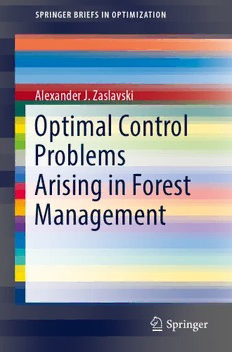Table Of ContentSPRINGER BRIEFS IN OPTIMIZATION
Alexander J. Zaslavski
Optimal Control
Problems
Arising in Forest
Management
123
SpringerBriefs in Optimization
SeriesEditors
SergiyButenko
MirjamDür
PanosM.Pardalos
JánosD.Pintér
StephenM.Robinson
TamásTerlaky
MyT.Thai
SpringerBriefs in Optimization showcases algorithmic and theoretical tech-
niques,casestudies,andapplicationswithinthebroad-basedfieldofoptimization.
Manuscripts related to the ever-growing applications of optimization in applied
mathematics, engineering, medicine, economics, and other applied sciences are
encouraged.
Moreinformationaboutthisseriesathttp://www.springer.com/series/8918
Alexander J. Zaslavski
Optimal Control Problems
Arising in Forest
Management
123
AlexanderJ.Zaslavski
DepartmentofMathematics
TheTechnion–IsraelInstituteofTechn
RishonLeZion,Israel
ISSN2190-8354 ISSN2191-575X (electronic)
SpringerBriefsinOptimization
ISBN978-3-030-23586-4 ISBN978-3-030-23587-1 (eBook)
https://doi.org/10.1007/978-3-030-23587-1
©TheAuthor(s),underexclusivelicensetoSpringerNatureSwitzerlandAG2019
Thisworkissubjecttocopyright.AllrightsarereservedbythePublisher,whetherthewholeorpartof
thematerialisconcerned,specificallytherightsoftranslation,reprinting,reuseofillustrations,recitation,
broadcasting,reproductiononmicrofilmsorinanyotherphysicalway,andtransmissionorinformation
storageandretrieval,electronicadaptation,computersoftware,orbysimilarordissimilarmethodology
nowknownorhereafterdeveloped.
Theuseofgeneraldescriptivenames,registerednames,trademarks,servicemarks,etc.inthispublication
doesnotimply,evenintheabsenceofaspecificstatement,thatsuchnamesareexemptfromtherelevant
protectivelawsandregulationsandthereforefreeforgeneraluse.
Thepublisher,theauthors,andtheeditorsaresafetoassumethattheadviceandinformationinthisbook
arebelievedtobetrueandaccurateatthedateofpublication.Neitherthepublishernortheauthorsor
theeditorsgiveawarranty,expressorimplied,withrespecttothematerialcontainedhereinorforany
errorsoromissionsthatmayhavebeenmade.Thepublisherremainsneutralwithregardtojurisdictional
claimsinpublishedmapsandinstitutionalaffiliations.
ThisSpringerimprintispublishedbytheregisteredcompanySpringerNatureSwitzerlandAG.
Theregisteredcompanyaddressis:Gewerbestrasse11,6330Cham,Switzerland
Preface
The growing importance of optimal control has been recognized in recent years.
This is due not only to impressive theoretical developments but also because of
numerous applications to engineering, economics, life sciences, etc. This book
is devoted to the study of a class of optimal control problems arising in forest
management.Theforestmanagementproblemisanimportantandinterestingtopic
inmathematicaleconomics thatwasstudiedbymanyresearchersincludingNobel
laureate P.A. Samuelson [68]. As usual, for this problem, the existence of optimal
solutions over infinite horizon and the structure of solutions on finite intervals are
underconsideration.Inourbooks[84,86],westudyaclassofdiscrete-timeoptimal
control problems which describe many models of economic dynamics except for
themodelofforestmanagement.Thishappensbecausesomeassumptionsposedin
[84, 86], which are true for many models of economic dynamics, do not hold for
the model of forest management. By this reason, the forest management problem
is not a particular case of general models of economic dynamics and is studied
separatelyintheliterature.Inthisbook,westudytheforestmanagementproblem
usingtheapproachintroducedandemployedinourresearch[80,81,83].Namely,
weanalyzeaclassofoptimalcontrolproblemswhichcontains,asaparticularcase,
theforestmanagementproblem.Forthisclassofproblems,weshowtheexistence
of optimal solutions over infinite horizon and study the structure of approximate
solutionsonfiniteintervalsandtheirturnpikeproperties,thestabilityoftheturnpike
phenomenon, and the structure of approximate solutions on finite intervals in the
regionsclosetotheendpoints.
InChap.1,weprovidesomepreliminaryknowledgeonturnpikeproperties.The
forestmanagementproblemisdiscussedinChap.2,whichalsocontainsexistence
resultsforinfinitehorizonproblems.InChap.3,weestablishtheturnpikeproperties
ofapproximatesolutions.Chapter4containsgenericturnpikeresults.Weconsider
aclassofoptimalcontrolproblemswhichisidentifiedwithacompletemetricspace
of objective functions and show the existence of a G everywhere dense subset of
δ
themetricspace,whichisacountableintersectionofopeneverywheredensesets,
suchthattheturnpikepropertyholdsforanyofitselement.Chapter5isdevotedto
v
vi Preface
thestudyofthestructureofapproximatesolutionsonfiniteintervalsintheregions
closetotheendpoints.InChap.6,weagainconsidertheforestmanagementproblem
andshowthattheresultsofChaps.3and5aretrueforit.
RishonLeZion,Israel AlexanderJ.Zaslavski
October30,2018
Contents
1 Introduction .................................................................. 1
1.1 ConvexDiscrete-TimeProblems...................................... 1
1.2 TheTurnpikePhenomenon............................................ 8
2 InfiniteHorizonOptimalControlProblems ............................. 11
2.1 TheForestManagementProblem..................................... 11
2.2 InfiniteHorizonProblemsWithoutDiscounting..................... 16
2.3 AuxiliaryResults ...................................................... 21
2.4 ProofsofTheorems2.6and2.7....................................... 23
2.5 ProofofTheorem2.9.................................................. 24
2.6 ProofofTheorem2.10 ................................................ 26
2.7 InfiniteHorizonProblemswithDiscounting......................... 27
2.8 AnAuxiliaryResultforTheorem2.13............................... 28
2.9 ProofofTheorem2.13 ................................................ 30
2.10 AnApplicationtotheForestManagementProblem................. 30
3 TurnpikeProperties ......................................................... 33
3.1 PreliminariesandMainResults....................................... 33
3.2 AuxiliaryResults ...................................................... 38
3.3 ProofofTheorem3.2.................................................. 44
3.4 ProofofTheorem3.3.................................................. 45
3.5 ProofofTheorem3.4.................................................. 47
3.6 ProofofTheorem3.5.................................................. 50
3.7 ProofofTheorem3.6.................................................. 51
3.8 StabilityResults ....................................................... 53
3.9 AgreeablePrograms................................................... 58
4 GenericTurnpikeProperties ............................................... 63
4.1 Preliminaries........................................................... 63
4.2 EquivalenceoftheTurnpikeProperties .............................. 64
4.3 GenericResults........................................................ 67
vii
viii Contents
5 StructureofSolutionsintheRegionsClosetotheEndpoints .......... 73
5.1 Preliminaries........................................................... 73
5.2 LagrangeProblems.................................................... 78
5.3 AnAuxiliaryResultforTheorem5.13............................... 83
5.4 ProofofTheorem5.13 ................................................ 85
5.5 TheFirstClassofBolzaProblems.................................... 89
5.6 AnAuxiliaryResultforTheorem5.15............................... 90
5.7 ProofofTheorem5.15 ................................................ 93
5.8 TheSecondClassofBolzaProblems................................. 98
5.9 AuxiliaryResultsforTheorem5.17.................................. 99
5.10 ProofofTheorem5.17 ................................................ 102
6 ApplicationstotheForestManagementProblem ....................... 109
6.1 Preliminaries........................................................... 109
6.2 AuxiliaryResults ...................................................... 112
6.3 TurnpikeResults....................................................... 118
6.4 GenericResults........................................................ 122
References......................................................................... 131
Index............................................................................... 135
Chapter 1
Introduction
Thestudyofoptimalcontrolproblemsandvariationalproblemsdefinedoninfinite
intervals and on sufficiently large intervals has been a rapidly growing area of
research [9, 10, 16, 18, 24, 37, 43, 48, 57, 59, 66, 76, 84–86] which has various
applicationsinengineering[1,44,87],inmodelsofeconomicgrowth[2,5,14,20,
23,28,38–40,47,52–55,60,61,63,65,67,68,70,77,80,81,83],inthegametheory
[29,32,42,74,82],ininfinitediscretemodelsofsolid-statephysicsrelatedtodis-
locationsinone-dimensionalcrystals[6,71],andinthetheoryofthermodynamical
equilibriumformaterials[19,45,50,51].Discrete-timeproblemswereconsidered
in [7, 8, 13, 21, 26, 30, 33, 72, 73, 78, 79] while continuous-time problems were
studiedin[3,4,11,12,15,17,22,25,27,31,41,46,49,56,58,62,69,75].
In this chapter we discuss turnpike properties for a class of simple convex
dynamicoptimizationproblems.
1.1 ConvexDiscrete-TimeProblems
Let Rn be the n-dimensional Euclidean space with the inner product (cid:2)·,·(cid:3) which
inducesthenorm
(cid:2) (cid:4)
(cid:3)n 1/2
|x|= x2 , x =(x ,...,x )∈Rn.
i 1 n
i=1
Let v : Rn × Rn → R1 be bounded from below function. We consider the
minimizationproblem
©TheAuthor(s),underexclusivelicensetoSpringerNatureSwitzerlandAG2019 1
A.J.Zaslavski,OptimalControlProblemsArisinginForestManagement,
SpringerBriefsinOptimization,https://doi.org/10.1007/978-3-030-23587-1_1
2 1 Introduction
T(cid:3)−1
v(xi,xi+1)→min, (P0)
i=0
suchthat{x }T ⊂Rnandx =z, x =y,
i i=0 0 T
whereT isanaturalnumberandthepointsy,z∈Rn.
Theinterestindiscrete-timeoptimalproblemsoftype(P )stemsfromthestudy
0
ofvariousoptimizationproblemswhichcanbereducedtoit,e.g.,continuous-time
controlsystemswhicharerepresentedbyordinarydifferentialequationswhosecost
integrand contains a discounting factor [43], tracking problems in engineering [1,
44, 87], the study of Frenkel-Kontorova model [6, 71], and the analysis of a long
slenderbarofapolymericmaterialundertensionin[19,45,50,51].Optimization
problemsofthetype(P )wereconsideredin[72,73].
0
Inthissectionwesupposethatthefunctionv :Rn×Rn →R1isstrictlyconvex
anddifferentiableandsatisfiesthegrowthcondition
v(y,z)/(|y|+|z|)→∞as|y|+|z|→∞. (1.1)
Weintendtostudythebehaviorofsolutionsoftheproblem(P )whenthepoints
0
y,zandtherealnumberT varyandT issufficientlylarge.Namely,weareinterested
tostudyaturnpikepropertyofsolutionsof(P )whichisindependentofthelength
0
of the interval T, for all sufficiently large intervals. To have this property means,
roughly speaking, that solutions of the optimal control problems are determined
mainly by the objective function v and are essentially independent of T, y, and z.
Turnpikepropertiesarewellknowninmathematicaleconomics.Thetermwasfirst
coinedbySamuelsonin1948(see[67])whereheshowedthatanefficientexpanding
economywouldspendmostofthetimeinthevicinityofabalancedequilibriumpath
(alsocalledvonNeumannpath).Thispropertywasfurtherinvestigatedforoptimal
trajectoriesofmodelsofeconomicdynamics(see,forexample,[47,53,65]andthe
referencesmentionedthere).Manyturnpikeresultsarecollectedin[76,84,86].
Inordertomeetourgoalweconsidertheauxiliaryoptimizationproblem
v(x,x)→min, x ∈Rn. (P )
1
Itfollowsfromthestrictconvexityofvand(1.1)thattheproblem(P )hasaunique
1
solutionx¯.Let
∇v(x¯,x¯)=(l ,l ), (1.2)
1 2
wherel , l ∈ Rn.Sincex¯ isasolutionof(P )itfollowsfrom(1.2)thatforeach
1 2 1
h∈Rn,
(cid:2)l ,h(cid:3)+(cid:2)l ,h(cid:3)=(cid:2)(l ,l ),(h,h)(cid:3)
1 2 1 2
= lim t−1[v(x¯ +th,x¯ +th)−v(x¯,x¯)]≥0.
t→0+

